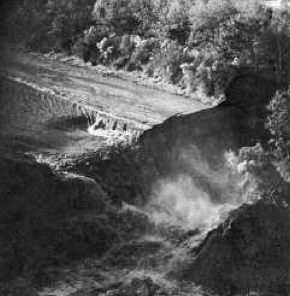Lake Peigneur facts for kids
Quick facts for kids Lake Peigneur |
|
|---|---|
| Location | Iberia Parish, Louisiana |
| Coordinates | 29°58′52″N 91°58′59″W / 29.981°N 91.983°W |
| Primary inflows | estimated 8.47 cu ft/s (0.240 m3/s) from catchment |
| Primary outflows | Delcambre Canal |
| Catchment area | 10.2 sq mi (26 km2) of the Vermilion-Teche Basin |
| Basin countries | United States |
| Surface area | 1,125 acres (455 ha) |
| Average depth | 3 ft (1 m) |
| Max. depth | 200 ft (61 m) |
Lake Peigneur (locally pronounced) is a brackish lake in the U.S. state of Louisiana, 1.2 miles (1.9 kilometers) north of Delcambre and 9.1 mi (14.6 km) west of New Iberia, near the northernmost tip of Vermilion Bay. With a maximum depth of 200 feet (60 meters), it is the deepest lake in Louisiana.
It was a 10-foot-deep (3 m) freshwater body, popular with sportsmen, until an unusual man-made disaster on November 20, 1980 changed its structure and the surrounding land.
Drilling disaster
On Thursday, November 20, 1980, the Diamond Crystal Salt Company salt mine under the lake filled with water. An oil rig contracted by Texaco was doing exploratory drilling above the mine at the time. The drilling likely started a chain of events that turned the shallow lake from fresh to brackish water, with a deep hole.
The evidence which could be used to identify the exact cause was destroyed or washed away in the ensuing maelstrom. However, the rig's 14-inch (36 cm) drill bit had become stuck just two-and-a-half hours before the draining was first observed. After the fact, engineers from Texaco and Diamond Crystal worked together to pinpoint the likely location of the hole which may have pierced the mine. They placed it within a mined out portion of the 1300-foot level of the mine. If the drill actually did puncture the roof of the mine, this would mean that Texaco had made a serious mistake about the location of the bore hole in relation to the mine. Whatever the precise cause, an opening formed in the bottom of the lake. The lake then drained into the hole, expanding the size of that hole as the soil and salt were washed into the mine by the rushing water, filling the enormous caverns that had been left by the removal of salt since 1919.
The resultant sinkhole swallowed the drilling platform, eleven barges holding supplies for the drilling operation, a tugboat, many trees, and 65 acres (26 hectares) of the surrounding terrain. So much water drained into the caverns that the flow of the Delcambre Canal that usually empties the lake into Vermilion Bay was reversed, causing salt water from the Gulf of Mexico to flow into what was now a dry lakebed. This backflow created for a few days the tallest waterfall ever in the state of Louisiana, at 164 ft (50 m), as the lake refilled with salty water from the Delcambre Canal and Vermilion Bay. Air displaced by water flowing into the mine caverns erupted through the mineshafts as compressed air and then later as 400-foot (120 m) geysers.
Although no human lives were lost, three dogs were reported killed. All 55 employees in the mine at the time of the accident were able to escape, with six employees later given awards by Diamond Crystal for heroism. The crew of 7 on the drilling rig fled the platform shortly before it collapsed into the new depths of the lake. A fisherman who was on the lake at the time was able to pilot his small boat to shore and escape. Days after the disaster, once the water pressure equalized, nine of the eleven sunken barges popped out of the whirlpool and refloated on the lake's surface.
Aftermath
Texaco and the drilling contractor Wilson Brothers paid $32 million to Diamond Crystal and $12.8 million to a nearby botanical garden and plant nursery, Live Oak Gardens, in out-of-court settlements to compensate for the damage caused. The Mine Safety and Health Administration released a report on the disaster in August 1981 which exhaustively documented the event but stopped short of identifying an official reason for the disaster. The mine was finally closed in December 1986.
Since 1994, AGL Resources has used Lake Peigneur's underlying salt dome as a storage and hub facility for pressurized natural gas. There was concern from local residents in 2009 over the safety of storing the gas under the lake and nearby drilling operations.
Salinity
The lake had salty water after the event, not as a result of salt from the mine dissolving into the water, but from the inflow of salty water from the Delcambre Canal and Vermilion Bay, which are naturally salty or brackish. The event permanently affected the ecosystem of the lake by changing the lake from freshwater to saltwater and increasing the depth of part of the lake.




